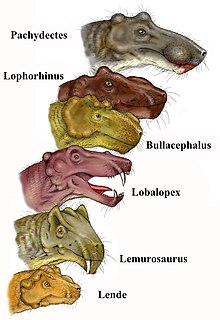| Pachydectes Temporal range: Middle Permian,
| |
|---|---|

| |
| Pachydectes (above) and other burnetiamorphs | |
| Scientific classification | |
| Domain: | Eukaryota |
| Kingdom: | Animalia |
| Phylum: | Chordata |
| Clade: | Synapsida |
| Clade: | Therapsida |
| Suborder: | †Biarmosuchia |
| Family: | †Burnetiidae |
| Genus: | †Pachydectes Rubidge et al., 2006 |
| Species: | †P. elsi
|
| Binomial name | |
| †Pachydectes elsi Rubidge et al., 2006
| |
Pachydectes is an extinct genus of biarmosuchian therapsids from the Middle Permian of South Africa known from a single skull.[1] The etymology of the name Pachydectes is derived from the Greek word pakhus, meaning "thick" or "thickened", and dektes, meaning "biter". In conjunction this name is representative of the unique pachyostotic bone present above the maxillary canine tooth found in the skull of the specimen.[1] There is only one known species within the genus, Pachydectes elsi which is named in honor of the person who discovered the fossil.
The holotype and only known specimen was found just above the Ecca-Beaufort contact in the eastern Karoo basin, which was a fluvial depositional environment.[2][3] As a member of the clade Biarmosuchia, Pachydectes retains many basal therapsid features, though with unique specializations one of which is the presence of adornments on the skull with horn-like protuberances.[1] Also as a member of this clade Pachydectes is thought to be carnivorous.
- ^ a b c Rubidge, B.S.; Sidor, C.A.; Modesto, S.P. (2006). "A new burnetiamorph (Therapsida: Biarmosuchia) from the Middle Permian of South Africa". Journal of Paleontology. 80 (4): 740–749. doi:10.1666/0022-3360(2006)80[740:ANBTBF]2.0.CO;2. S2CID 130196490.
- ^ Rubidge BS, Hancox JP, Mason R. Waterford Formation in the south-eastern Karoo: Implications for basin development. S Afr J Sci. 2012;108(3/4), Art. #829, 5 pages. http://dx.doi.org/10.4102/sajs.v108i3/4.829
- ^ Rubidge, Bruce, S (2001). "Evolutionary Patterns among Permo-Triassic Therapsids". Annual Review of Ecology and Systematics. 32: 449–480. doi:10.1146/annurev.ecolsys.32.081501.114113. JSTOR 2678648 – via JSTOR.
{{cite journal}}: CS1 maint: multiple names: authors list (link)